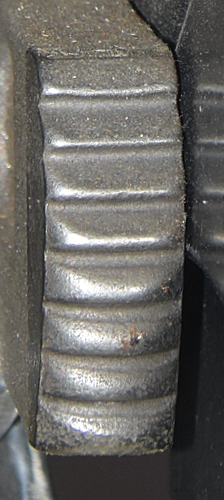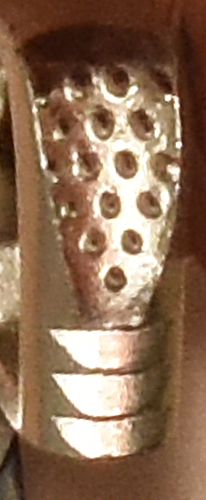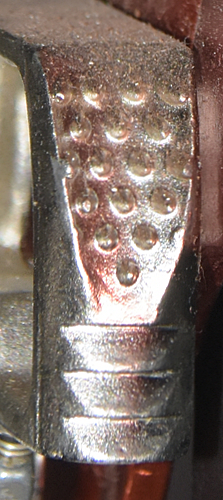Overview
[ Top
| Version B
| Version C
| Return to L.C. Ascenders
]
Version A
(#55, 2958)
Technical Details
I acquired this pair of ascenders from Speleoshoppe in 1982. I acquired an additional left ascender from Jasmine Mikulecky in 2020.
Version A is 206 mm. tall, 94 mm. wide, 30 mm. thick, and weighs 237 g.
The Kong-Bonaiti ascender shell consists of a number of parts.
The main piece is a black anodized 2.7 mm. aluminum stamping which
forms the rope channel, the upper portion of the ascender, and
the side of the hand hole opposite the hand grip. The rope channel is 14 mm. wide. Two reinforcing
ribs are stamped into the upper part of this piece and reinforce
the rope channel. A 13.5 mm. hole through the top part of the
rope channel provides an upper sling attachment point.
 The cam is mounted on the upper shell using a special 8 mm.
shoulder bolt and special nut. The cam axle is centered 29 mm. from the inside of the rope channel. The nut is center punched on the
back side of the ascender to keep the bolt from unscrewing. A
cam spring mounted on this bolt tends to close the cam. This spring
is not visible without disassembling the ascender. The cam is
a plated steel casting. The cam face is convex, not concave, and
has 8 cast teeth. The tooth pattern is (4.3)^2(2.1)(Z)^4. The top tooth has a pronounced "Z" profile, but
the lower teeth become progressively more rounded until the lowest
tooth has an almost semicircular profile. The cam radius increases from 20 to 47 mm. over an angle of 51°, giving a 30° cam angle.
The cam is mounted on the upper shell using a special 8 mm.
shoulder bolt and special nut. The cam axle is centered 29 mm. from the inside of the rope channel. The nut is center punched on the
back side of the ascender to keep the bolt from unscrewing. A
cam spring mounted on this bolt tends to close the cam. This spring
is not visible without disassembling the ascender. The cam is
a plated steel casting. The cam face is convex, not concave, and
has 8 cast teeth. The tooth pattern is (4.3)^2(2.1)(Z)^4. The top tooth has a pronounced "Z" profile, but
the lower teeth become progressively more rounded until the lowest
tooth has an almost semicircular profile. The cam radius increases from 20 to 47 mm. over an angle of 51°, giving a 30° cam angle.
The cam extends past
the pivot and downwards at a 40° angle to a second pivot pin
located about 29 mm. from the main pivot. A second "L"
shaped 2.7 mm. aluminum frame piece extends downwards from this
pivot, forming the hand grip side and bottom of the hand hole.
A well rounded 13.9 mm. hole at the bottom of this piece forms
the main sling attachment point. This piece has a phosphorescent
plastic hand grip with four finger grooves molded onto it. It
also has a small metal tab riveted in place above the hand grip.
This tab engages the cam safety to hold the cam open.
The bottom of the main shell and the bottom of the "L"
shaped piece are connected by a short, curved piece of 2.7 mm.
aluminum. This piece is connected to the other two by one rivet
each. The rivets are set loosely so the connections are free to
rotate.
The cam and three frame pieces form a parallelogram where all
four corners are free to rotate. As a result, raising the hand
grip raises the end of the cam opposite the rope, thus lowering
the end near the rope and pivoting the cam open. During this operation,
the hand grip ("L" shaped piece) moves upwards with
respect to the main frame piece. The cam spring opposes this motion,
so it acts to raise the main shell. At first friction against
the rope prevents this and the cam starts to open, but eventually
the cam no longer has enough friction on the rope, and the ascender
moves upwards. When weight is applied, the cam spring acts to
close the cam, and this action coupled with the climber’s weight
moves the "L" shaped piece downwards. The climbers weight
is transferred to the cam by the "L" shaped piece. The
cam exerts enough normal force on the rope to prevent sliding,
and the climbers weight is held.
The cam safety is a small lever mounted on the bottom of the
cam with a 3 mm. solid rivet. A small coil spring connects a second
pin in the cam with a hole in the cam safety and pulls the safety
upwards. This arrangement is opposite that used in the Petzl where
the cam safety spring is in compression. A small cylinder mounted
on the safety acts as a thumb knob. Under normal operation the
cam safety hits the tab on the "L" shaped piece when
the cam opens, thus limiting the amount the cam can open. By pulling
down on the thumb knob, the safety can clear the tab. If desired
a hook on the top of the safety can be latched around the tab
to keep the cam open.
The main shell piece is stamped "<-> KG. 650"
with the double arrow aligned vertically. The hand grip has "PHOSPHORESCENT"
molded in one side and "BONAITI-KONG-ITALY" molded in
the other.
This is an unusual ascender which operates on an entirely
different set of principles than handled eccentric cam ascenders.
The moving frame takes some time to get used to if you are accustomed
to other handled ascenders. One disadvantage is that this ascender
is more difficult to push up the rope, particularly if the rope
is hanging against a wall with one’s weight on it. This situation
can often be avoided by proper pit rigging. The two lower rivets
appear rather small to the uninitiated, but they do not carry
any weight so there is little cause for concern. The sheet metal
shell has the same potential bending problem as all other sheet
metal shells discussed in this site. The sling attachment holes
could have the same safety problem described for the Clog
Expedition ascenders. Like the Petzl
Ascension, a carabiner through the top hole prevents putting
the ascender on or off rope.
The workmanship on this ascender appears to be quite good.
All frame edges are rounded. The two lower rivets have some sharp
edges, but they are on the side opposite the rope so there is
little chance for rope damage here. I like the phosphorescent
handle, even if it really doesn't offer any substantial practical
advantage.
This ascender gives a little more lost motion than the other
handled ascenders for two reasons. The first is the pivoting action
of the handle. The other is that the sling attachment point is
located farther from the main rope, so the ascender cants away
from the vertical with each step. On the other hand, the lever
cam design is less sensitive to rope conditions than eccentric
cam designs. In particular, the Kong-Bonaiti ascenders can be
expected to hold under some mud and ice conditions where the handled eccentric cam ascenders ascenders
slip.
[ Top
| Version A
| Version C
| Return to L.C. Ascenders
]
Version B
(#3633)
Technical Details
 Dirk Stoffels sent me this ascender in 2024.
Dirk Stoffels sent me this ascender in 2024.
This version is 206 mm. tall, 95 mm. wide, 30 mm. thick, and weighs 263 g.
This ascender is similar to the previous version but
the cam assembly has changed. The cam now uses a combination tooth
design. The top 60% of the cam face is a concave surface with
some poorly formed conical teeth oriented parallel to the top
of the cam. Below these are
four convex "Z" shaped teeth. The resulting tooth pattern is (4.3)^2(2.1)(Z)^4. The conical teeth are
in contact with the rope, even for excessively small (e.g., 6 mm. ) main lines.
The cam safety has been modified slightly. The tension spring
has been replaced by a compression spring located below the safety.
The thumb knob is now drilled and tapped, and an auxiliary pin
extension is available to screw into this hole. This extends the
thumb knob by 12.2 mm.
The main shell piece is stamped "<-> KG. 650"
with the double arrow aligned vertically. The hand grip has "PHOSPHORESCENT"
molded in one side and "BONAITI-KONG-ITALY" molded in
the other.
This is an improved ascender compared to Version A. The conical
teeth help improve holding ability when the ropes are not too
muddy or icy. The compression spring is stronger than the old
cam safety spring, and does its job a little better. The optional
pin extension is nice. I consider it to be better than the knurled
one once used on the Petzl Ascension.
I prefer not to use the extension since it tends to catch on things,
but the extension is helpful when wearing winter gloves. If
you choose to use it, I recommend using thread-locker to make
the pin a quasi-permanent addition to the ascender.
[ Top
| Version A
| Version B
| Return to L.C. Ascenders
]
Version C
(#56, 1556, 2107, 3670)
Technical Details
 I acquired this pair of ascenders from Speleoshoppe in 1985. I acquired a third (right-hand) ascender from Robert Blake in 2011. I acquired another pair in 2017 as part of Bob Thrun’s collection, and a green left-handed one from Kent Koptiuch in 2025
I acquired this pair of ascenders from Speleoshoppe in 1985. I acquired a third (right-hand) ascender from Robert Blake in 2011. I acquired another pair in 2017 as part of Bob Thrun’s collection, and a green left-handed one from Kent Koptiuch in 2025
This version is 206 mm. tall, 95 mm. wide, 30 mm. thick, and weighs 263 g.
"STATIC ROPE Ø 12 KG ↔ 650" and "UIAA ROPE Ø 9 KG↔ 650" are stamped on the open side of the shell, and "BONAITI-KONG-ITALY’ is stamped on the back. The hand grip has "PHOSPHORESCENT"
molded in one side and "BONAITI-KONG-ITALY" molded in
the other.
This version is identical to the previous one except the ascender shell markings were changed.
[ Top
| Version A
| Version B
| Version C
]


